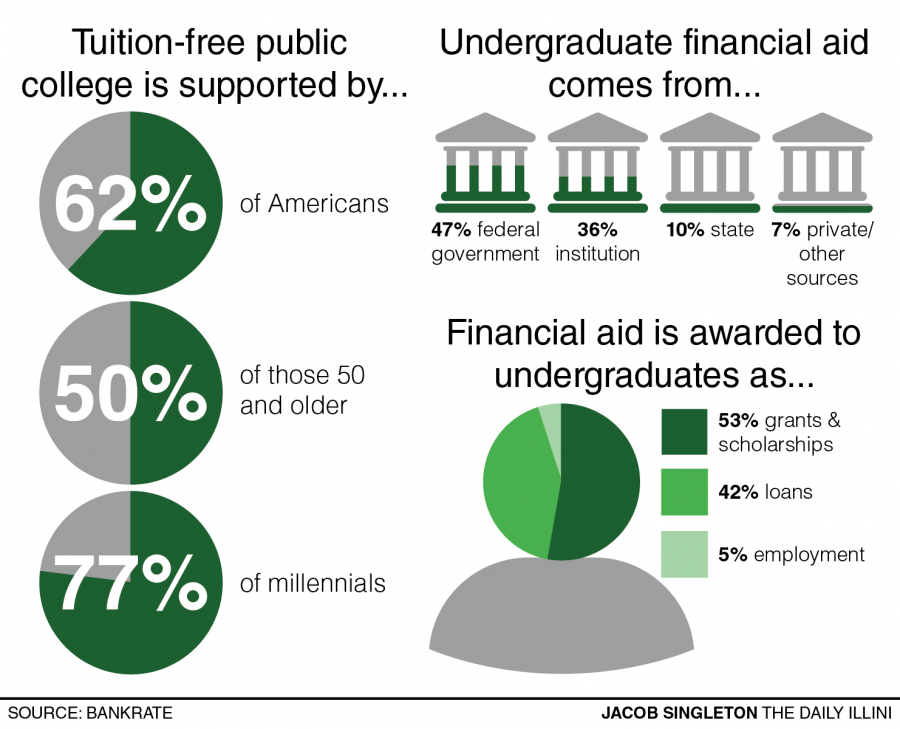Financial aid remains uncertain amid state budget crisis
Sep 5, 2016
Due to the continuing state budget crisis, financial aid is in jeopardy for the 69 percent of students who rely on it to fund their education.
And for some freshmen, financial aid was an important factor in choosing which college to attend.
“I received about $15,000 from Ohio State and even more from Mizzou, however, even with that money, the ending price I’d be paying per year was comparable for all schools,” said Deangelo Medrano in an email. He is a freshman in LAS.
Other Big Ten schools report awarding less financial aid to students than the University. Northwestern University granted $160 million to 62 percent of its undergraduates, and Indiana University at Bloomington awarded $328 million to 66 percent of its students.
According to an email from Dan Mann, director of student financial aid, the University anticipates awarding around $800 million in financial aid. The funding comes from the federal government, the state government, the University and other private sources.
Get The Daily Illini in your inbox!
While the University did receive stopgap funding from the state legislature, there are still aspects of financial aid that remain uncertain.
“Our biggest concern continues to be funding for the state of Illinois Monetary Award Program (MAP) Grant,” said Mann. “The University has credited the Fall 2016 MAP Grant awards to students’ accounts, but students could be required to repay these funds if the state of Illinois does not provide funding for this program.”
A situation in which the state stops funding the MAP Grant program would be detrimental to a large number of students, as University students receive over $26 million in MAP Grant funds every year.
Despite the uncertainty surrounding the state budget, financial aid is still being awarded for this school year.
“We won’t know the final amount of financial aid awarded/disbursed until the year is over, but we anticipate that the total will be more than $800 million,” Mann said.
Even students who don’t receive the MAP Grant funding are preoccupied with the budget’s effect on their financial aid package.
“Sixty-six percent of my scholarship(s) is from the school and I am concerned because I don’t think financial aid at UIUC can sustain itself for long without a state budget,” said Jassiem Renfro in an email, freshman in Business.
Medrano said he is also worried about the budget.
“I know that the budget crisis is affecting all schools and one of the main reasons I came here was because of the vast amount of resources the school has,” he said. “The idea that those resources are in danger because of financial instability is frightening.”
Both freshmen expressed that while what they had received in financial aid is what they had expected, they both had wished for more.
“I did not receive any aid from the university or from FAFSA (even with an older brother in college and a younger brother in private high school), but I did earn the presidential scholarship from the university,” Medrano said.
With financial aid being a determining factor in whether a student can attend college, many students support tuition-free college. In a survey conducted by Bankrate that polled 1,000 people, 62 percent of Americans said they would support tuition-free public college. In this poll, 77 percent of people ages 18 to 29, or “millennials,” supported this proposal.
“I absolutely think higher education should be tuition-free. So many young adults with a lot of potential are not able to succeed because of a lack of access to affordable education,” Renfro said.
Not every millennial shares this sentiment.
“I disagree that college should be free. Especially with schools as big as U of I, it is understandable that some debts have to be paid through tuition,” said Medrano. “I do, however think that going through college should be much more affordable so that so many more people have the opportunity to get a great education.”






